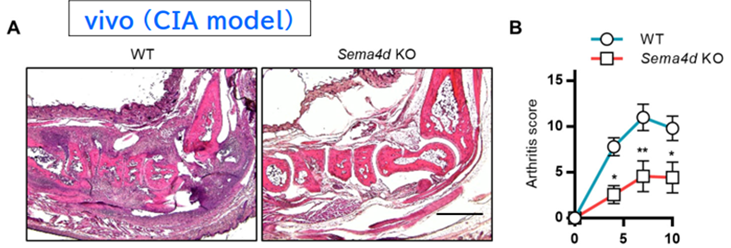Advantages
- Discovery of a Novel Drug Target: Identified the inflammatory cytokine Sema4D, which is involved in the progression of rheumatoid arthritis, along with its novel signaling pathway and target gene expression mechanisms, enabling a new therapeutic strategy.
- Potential for Various Drug Development Approaches: With intracellular signaling elucidated, development is possible across multiple modalities, including small-molecule drugs, antibody therapeutics, and mRNA-based medicines.
- Establishment of a Screening System: A primary cell-based evaluation system has been established.
Technology Overview & Background
The onset and progression of rheumatoid arthritis are closely associated with inflammatory cytokines such as interleukin-1 (IL-1), tumor necrosis factor-alpha (TNFα), and interleukin-6 (IL-6). While drugs that inhibit these cytokines have demonstrated certain clinical effects, they are not effective for all patients and pose serious immune-related side effects such as increased susceptibility to infections.
This study identified Sema4D as a novel inflammatory cytokine that could serve as a new therapeutic target for rheumatoid arthritis by inducing cartilage destruction.
- Sema4D is derived from macrophages and has been shown to induce cartilage-degrading enzymes and trigger inflammatory responses via the NF-κB and c-Met-Ras-Erk 1/2 pathways, leading to cartilage destruction.
- In Sema4D knockout (KO) mice, cartilage destruction was significantly reduced.
- Blocking these signaling pathways successfully suppressed cartilage damage.
These findings suggest that Sema4D is a promising new therapeutic target for rheumatoid arthritis. Currently, Sema4D’s signaling pathway has been elucidated, and a high-sensitivity and simplified screening system using primary cells from genome-edited animals has been established. Based on this knowledge, new mRNA and peptide therapeutics targeting Sema4D can be developed, offering promising clinical applications in the future.
Data
- Sema4D knockout (KO) mice were generated and subjected to the collagen-LPS-induced arthritis (CIA) model. The results demonstrated that cartilage destruction was significantly reduced in Sema4D KO mice compared to wild-type mice.
- In a culture experiment using femoral heads isolated from 3-week-old ICR mice, the addition of Sema4D along with the NF-κB inhibitor (BAY11-7082) and the c-Met inhibitor (SU11274) resulted in the suppression of Mmp13 gene expression.
 |
Patent and Publication
WO/2022/137964
https://doi.org/10.1126/scisignal.abl5304
Principal Investigator & Academic Institution
Professor Riko Nishimura (Graduate School of Dentistry, The University of Osaka)
Expectations
Our research laboratory possesses a screening system for joint cartilage cells using primary cells and knock-in mouse technology. We are currently conducting research and development on candidate molecules for mRNA therapeutics. At The University of Osaka, we seek pharmaceutical companies interested in drug development and collaborative research targeting the signaling pathways identified in this study using our advanced technologies.
Project No.WL-03452


